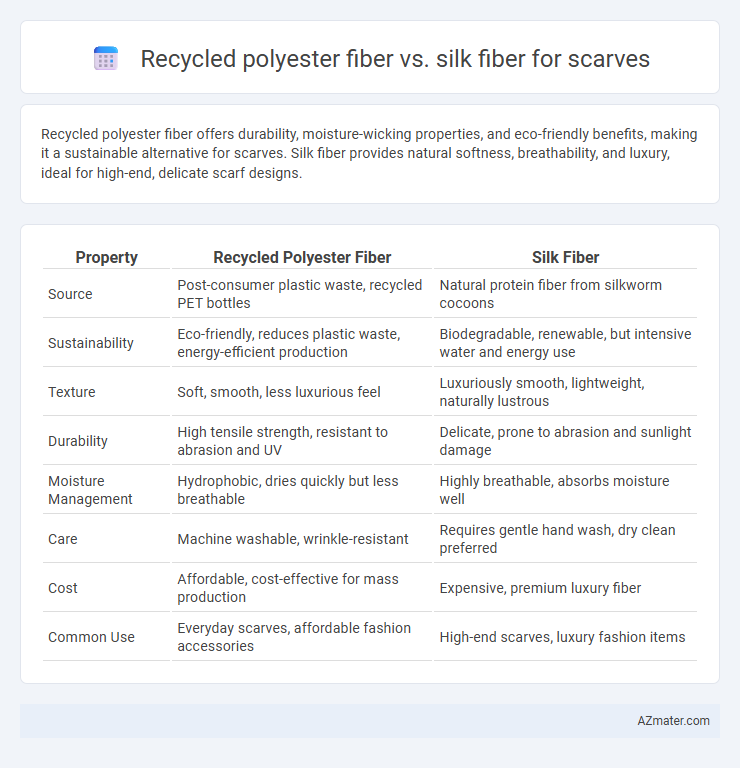Recycled polyester fiber offers durability, moisture-wicking properties, and eco-friendly benefits, making it a sustainable alternative for scarves. Silk fiber provides natural softness, breathability, and luxury, ideal for high-end, delicate scarf designs.
Table of Comparison
| Property | Recycled Polyester Fiber | Silk Fiber |
|---|---|---|
| Source | Post-consumer plastic waste, recycled PET bottles | Natural protein fiber from silkworm cocoons |
| Sustainability | Eco-friendly, reduces plastic waste, energy-efficient production | Biodegradable, renewable, but intensive water and energy use |
| Texture | Soft, smooth, less luxurious feel | Luxuriously smooth, lightweight, naturally lustrous |
| Durability | High tensile strength, resistant to abrasion and UV | Delicate, prone to abrasion and sunlight damage |
| Moisture Management | Hydrophobic, dries quickly but less breathable | Highly breathable, absorbs moisture well |
| Care | Machine washable, wrinkle-resistant | Requires gentle hand wash, dry clean preferred |
| Cost | Affordable, cost-effective for mass production | Expensive, premium luxury fiber |
| Common Use | Everyday scarves, affordable fashion accessories | High-end scarves, luxury fashion items |
Introduction to Scarf Materials: Recycled Polyester vs Silk
Recycled polyester fiber is an eco-friendly alternative made from post-consumer plastic waste, offering durability, wrinkle resistance, and moisture-wicking properties ideal for scarves. Silk fiber, a natural protein fiber produced by silkworms, is prized for its luxurious softness, breathability, and natural sheen, providing a lightweight and elegant scarf option. Both materials serve distinct purposes in scarf production, with recycled polyester emphasizing sustainability and resilience, while silk emphasizes comfort and premium aesthetics.
Sustainability and Eco-Friendliness Compared
Recycled polyester fiber for scarves significantly reduces plastic waste by repurposing PET bottles, lowering carbon emissions compared to virgin polyester production. Silk fiber, while biodegradable and natural, involves resource-intensive mulberry cultivation and silkworm farming, which can impact water and land use. Choosing recycled polyester supports circular economy principles and decreases environmental footprint, whereas silk offers biodegradability but with higher resource consumption.
Production Processes: Recycled Polyester Fiber vs Silk
Recycled polyester fiber is produced by melting and re-spinning plastic waste, reducing environmental impact through resource reuse and lower water consumption, whereas silk fiber is harvested from silkworm cocoons in a labor-intensive process involving boiling and reeling. The production of recycled polyester fiber relies heavily on synthetic materials and mechanical recycling technologies, contrasting with silk's natural biological extraction that requires large-scale sericulture and significant land use. These differences impact the sustainability and cost efficiency of scarves made from each fiber, with recycled polyester offering a more eco-conscious option and silk providing a premium, natural textile choice.
Texture and Feel: Comfort Analysis
Recycled polyester fiber offers a smooth and slightly stiff texture, providing durability and moisture-wicking properties that enhance comfort in scarves, especially for everyday wear. Silk fiber is renowned for its natural softness, luxurious sheen, and excellent breathability, delivering a lightweight and silky feel that drapes elegantly against the skin. Comparing comfort levels, silk fibers typically outperform recycled polyester in softness and thermal regulation, while recycled polyester excels in resilience and ease of maintenance.
Durability and Longevity of Each Fiber
Recycled polyester fiber offers superior durability and resistance to wear, making it ideal for scarves subjected to frequent use and washing. Silk fiber, while luxurious and soft, is more delicate and prone to damage from abrasion, sunlight, and moisture, reducing its longevity in everyday wear. Scarves made from recycled polyester maintain their shape and color longer, whereas silk requires careful handling to preserve its natural sheen and strength.
Breathability and Moisture Management
Recycled polyester fiber offers superior moisture management compared to silk fiber due to its hydrophobic properties, which wick sweat away from the skin, keeping the scarf dry and comfortable. Silk fiber, while naturally breathable and lightweight, tends to absorb moisture rather than wick it, which can lead to a clammy feeling during prolonged wear. For breathability, silk provides excellent airflow through its natural protein structure, whereas recycled polyester's engineered fibers can be designed to balance breathability with enhanced moisture control.
Cost Comparison: Affordability and Value
Recycled polyester fiber offers a significantly lower cost compared to silk fiber, making it a more affordable option for scarves without compromising durability. Silk fiber, known for its luxury and natural sheen, commands higher prices due to its labor-intensive production and premium quality. Consumers seeking value often choose recycled polyester for budget-friendly scarves that still provide softness and breathability.
Color and Print Versatility
Recycled polyester fiber offers superior color retention and print versatility for scarves due to its synthetic composition, allowing vibrant, long-lasting hues and intricate, high-definition patterns. Silk fiber, while luxurious and naturally lustrous, tends to have limitations in color fastness and print complexity, often requiring delicate care to maintain vibrancy. Choosing recycled polyester enhances durability and design flexibility, making it ideal for bold, colorful scarf styles with diverse print options.
Allergenicity and Skin Sensitivity
Recycled polyester fiber offers hypoallergenic properties, making it less likely to cause allergic reactions or irritation on sensitive skin compared to natural silk fiber, which may sometimes trigger contact dermatitis in individuals allergic to sericin or other proteins present in silk. Silk fiber's smooth texture is gentle but may carry residual allergens from sericin, whereas recycled polyester undergoes rigorous processing to remove contaminants, enhancing its safety for sensitive skin. For scarves worn close to the skin, recycled polyester provides a more consistent hypoallergenic experience, while silk requires careful consideration for allergy-prone users.
Style and Fashion Trends: Polyester vs Silk Scarves
Recycled polyester fiber scarves offer vibrant color retention and diverse patterns that align with contemporary eco-conscious fashion trends, making them a popular choice for sustainable style statements. Silk scarves, renowned for their luxurious texture and natural sheen, embody timeless elegance and are favored in classic and high-end fashion circles. While recycled polyester promotes durability and modern versatility, silk maintains its status as an iconic accessory for sophisticated and traditional scarf designs.

Infographic: Recycled polyester fiber vs Silk fiber for Scarf
 azmater.com
azmater.com